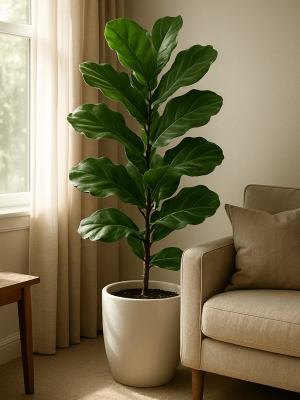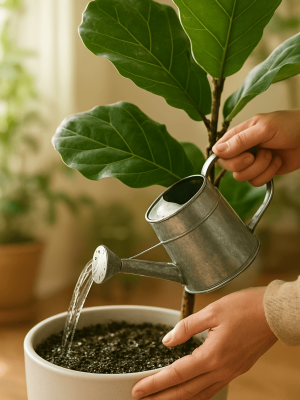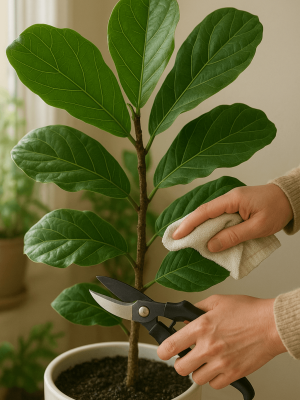The Ultimate Fiddle Leaf Fig Care Guide: Grow and Style Your Ficus lyrata Like a Pro
Introduction: Why the Fiddle Leaf Fig Rules the Indoor Plant World
The Fiddle Leaf Fig (Ficus lyrata) has become an undeniable icon in modern interior design. With its large, violin-shaped glossy leaves and upright growth, it adds instant drama and elegance to any space. Originally from West and Central Africa, this plant thrives in warm, humid conditions and can grow into a towering tree outdoors — but indoors, it’s usually kept between 2–10 feet.
Loved by interior designers, bloggers, and plant enthusiasts alike, the Fiddle Leaf Fig isn’t just a decorative piece; it’s a statement plant. However, it’s also known for being “fussy,” which makes growing a healthy one all the more satisfying.

1. Understanding Your Fiddle Leaf Fig
Native Habitat and Behavior
In its natural rainforest habitat, the Fiddle Leaf Fig enjoys bright, filtered sunlight, high humidity, and stable temperatures year-round. Indoors, it needs similar conditions to thrive. Its sensitivity to environmental changes explains why sudden moves or light shifts often trigger leaf drop.
Popular Varieties
Ficus lyrata ‘Standard’ – Tall, large leaves; perfect for statement corners.
Ficus lyrata ‘Compacta’ – Shorter, bushier growth; ideal for smaller rooms.
Ficus lyrata ‘Bambino’ – Miniature size; great for desks or shelves.
Ficus lyrata ‘Variegata’ – Rare, cream-edged leaves; visually stunning.
2. Light: The Key to Thriving Growth
Fiddle Leaf Figs are light lovers. They need bright, indirect light for most of the day. An east-facing window is ideal, or position them a few feet away from a sunny south/west window. Avoid harsh afternoon sun unless the plant has been slowly acclimated, as sudden exposure can cause leaf burn.
Pro Tip: Rotate your plant every 1–3 weeks to encourage even growth and prevent leaning.
3. Watering: Striking the Right Balance
The golden rule? Water when the top 1–2 inches of soil are dry. Typically:
Spring/Summer: Every 7–10 days
Fall/Winter: Every 10–14 days
Overwatering leads to root rot, while underwatering causes crispy leaf edges. Always use pots with drainage holes, and empty the saucer after watering.

4. Temperature & Humidity: Mimicking the Tropics
Temperature: 65–85°F (18–30°C) daytime, not below 60°F (15°C) at night.
Humidity: 40–65% is optimal.
Avoid cold drafts, heating vents, and sudden temperature swings.
Humidity Boosters:
Use a humidifier
Pebble tray with water
5. Soil & Potting: The Foundation of Plant Health
Fiddle Leaf Figs need well-draining yet moisture-retentive soil. A good mix:
2/3 peat or coco coir
1/3 perlite or pine bark
pH Range: 6–7 (neutral to slightly alkaline).
Never add gravel at the bottom — it traps water and causes rot.
6. Fertilization: Feeding for Lush Growth
During spring through fall, feed with a 3-1-2 NPK fertilizer every 2 weeks or diluted with every watering.
In winter, pause fertilizing.
Flush soil monthly to prevent salt buildup.
7. Repotting: When Your Plant Outgrows Its Home
Repot every 2–3 years (annually for young plants). Signs it’s time:
Roots circling the pot or coming through drainage holes
Soil pulling away from pot edges
Stunted growth
Choose a pot only 2–3 inches larger to avoid excess moisture retention.
8. Pruning & Shaping: Styling Your Statement Plant
Bushier Look: Pinch off top growth to encourage branching.
Tree Form: Remove lower leaves to expose the trunk.
Notching: Make shallow cuts above a node to trigger side growth.
Strength Training: Gently wiggle the trunk to simulate wind.

9. Cleaning & General Maintenance
Dust blocks light absorption. Wipe leaves with a damp cloth monthly to boost photosynthesis. Avoid oils or leaf shine sprays that clog pores.
Rotate regularly for even growth and inspect weekly for pests or stress signs.
10. Troubleshooting Common Problems
Brown Edges
Cause: Underwatering or low humidity
Fix: Water deeply, raise humidity
Dark Brown Spots
Cause: Overwatering, root rot, bacterial infection
Fix: Improve drainage, trim damaged roots, repot
Yellow Leaves
Cause: Low light, nutrient deficiency, pests
Fix: Increase light, fertilize, check for pests
Leaf Drop
Cause: Environmental shock, watering issues
Fix: Keep conditions stable, adjust care routine
Sunburn
Cause: Sudden direct sun
Fix: Move to filtered light, acclimate slowly
Quick Care Reference Table
| Care Factor | Best Practice |
|---|---|
| Light | Bright, indirect light |
| Water | When top 1–2 inches dry |
| Temperature | 65–85°F |
| Humidity | 40–65% |
| Soil pH | 6–7 |
| Fertilizer | 3-1-2 NPK in growing season |
| Repotting | Every 2–3 years |
| Pruning | Spring for shaping |
Final Thoughts
Growing a Fiddle Leaf Fig is both an art and a science. With the right balance of light, water, humidity, and nutrients, this plant can become the centerpiece of your home. While it may be known for being temperamental, the reward of lush, sculptural foliage is worth the effort. Treat it with consistency, and your Fiddle Leaf Fig will thrive for years.
FAQ 1
Question: How often should I water my fiddle leaf fig?
Answer: Water your fiddle leaf fig when the top 1–2 inches (2.5–5 cm) of soil are dry. Typically every 7–10 days in spring/summer and 10–14 days in fall/winter. Avoid letting the soil stay soggy.
FAQ 2 Question: Why are my fiddle leaf fig leaves turning brown?
Answer: Brown leaves can result from overwatering, underwatering, low humidity, direct sunlight burn, or root rot. Check soil moisture, increase humidity, and adjust watering as needed.
